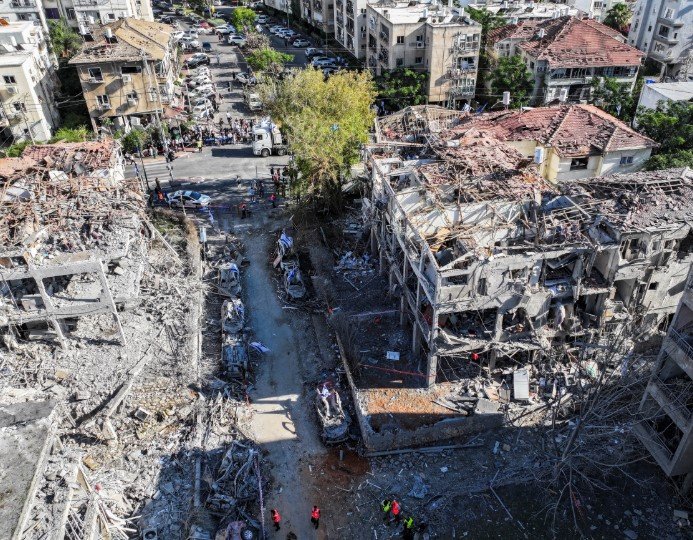Reconstruction Begins as Iran’s June Barrage Exposes Gaps in Israeli Air Defenses
In a rare admission, Israeli officials have confirmed that Prime Minister Benjamin Netanyahu’s office inside the Kirya military complex in Tel Aviv sustained damage from Iran’s unprecedented missile strike in late June. The office has been evacuated and will remain closed for at least four months, Israeli media reported Wednesday.
The attack, which formed part of a broader Iranian retaliation for Israeli strikes on its nuclear and military infrastructure, marked a turning point in the conflict that erupted on June 13. While Israel has consistently touted the strength of its multi-layered defense systems, the fallout from this strike is forcing both a public reckoning and a behind-the-scenes overhaul.
The Kirya Complex Takes a Direct Hit
The Kirya complex — Israel’s equivalent of the Pentagon — isn’t just a military nerve center. It’s symbolic. It’s where strategy is crafted, policies are debated, and decisions with regional ripple effects are made. And it’s where Benjamin Netanyahu’s office has operated, until now.
Sources close to the prime minister told the Israeli outlet Walla! that the office, officially known as Beit Shimon Peres (formerly “Building 22”), has been deemed unfit for use following structural damage caused by Iran’s ballistic missiles. Satellite images reviewed by The Telegraph reportedly show clear evidence of missile strikes within the perimeter of the Kirya.
The site will now undergo months of reconstruction, with infrastructure teams racing to make repairs. Until then, Netanyahu and senior military procurement officials will be working out of temporary quarters.

Iran’s Missiles Breached Israel’s Multi-Layered Shield
The Iranian barrage launched in late June involved more than 200 ballistic missiles, many of them high-velocity weapons capable of traveling at hypersonic speeds. Iran’s intention, according to its military statements, was to target “critical infrastructure and strategic command centers” within Israel.
Despite Israel deploying its sophisticated air defense network — including Iron Dome, David’s Sling, and the Arrow-3 interceptor system — roughly 10% of the incoming missiles reportedly got through.
That 10% was enough to cause real damage.
According to military analysts cited by The Telegraph, the David’s Sling system, which is supposed to neutralize medium-range threats, struggled under the weight of the attack. The system had previously been considered a success in intercepting threats from Hezbollah and Hamas, but it now faces serious questions about its capacity to withstand a full-scale missile assault from a state actor like Iran.
One paragraph, one sentence: A military official confirmed that some Israeli installations were directly hit.
From Retaliation to Public Revelation
This marks the first time Israel has publicly acknowledged that Iranian missiles damaged a military installation within the country. For weeks, the Israeli Defense Forces (IDF) had maintained a tight-lipped posture, neither confirming nor denying claims of successful strikes inside Tel Aviv.
That silence was partly strategic — officials didn’t want to give Tehran the satisfaction of knowing what worked. But as reconstruction begins, and with Netanyahu’s office shuttered, hiding the damage is no longer possible.
A senior official involved in the repair work told Israeli reporters that the structural damage was significant enough to threaten the building’s operational integrity.
“This isn’t cosmetic,” the official said. “Without repairs, you simply can’t keep people in there.”
Critical Infrastructure and What’s at Stake
Beyond the symbolic loss, the real concern lies with what the building represented: a hub for both civilian and military operations tied to national security and defense procurement. Though some of those functions had already moved to the nearby Matkal Tower, Beit Shimon Peres still housed several sensitive departments.
-
The Prime Minister’s Office (PMO) command unit
-
Strategic procurement wings tied to the Ministry of Defense
-
Data management systems linked to Israel’s military R&D division
Notably, some internal reports suggest that the missile’s impact prompted a reevaluation of where and how classified systems are stored and shielded.
One sentence paragraph: Some operations have already begun shifting to hardened underground bunkers near Jerusalem.
Table: Breakdown of Israel’s Air Defense Interception Rates (June 13–June 25 Conflict)
| Missile Defense System | Intended Threat Type | Estimated Interception Rate | Known Issues Reported |
|---|---|---|---|
| Iron Dome | Short-range rockets | ~90% | Overload during peak barrages |
| David’s Sling | Medium-range missiles | ~75% | Gaps in overlapping coverage |
| Arrow-3 | Long-range ballistic threats | ~85% | Hypersonic limitations |
The numbers are estimates based on independent military analysts and open-source reporting. Official IDF data remains classified.
Tehran’s Message Lands Loud and Clear
Tehran’s barrage in late June was its biggest missile launch since the Iran-Iraq war of the 1980s — and the first aimed directly at major Israeli command structures.
Iran’s Foreign Ministry has repeatedly stated that the strike was “a direct and lawful response” to the Israeli bombing of Iranian military and civilian assets earlier that month. Their targets included research centers, nuclear facilities, and IRGC logistics hubs.
And while the Israeli side insists that its defenses worked as intended — intercepting the majority of threats — the Kirya hit speaks louder than any press release.
Even Israel’s usual allies have remained muted. While U.S. officials reaffirmed Israel’s right to self-defense, there has been no public comment on the Kirya damage.
Meanwhile, Iranian state TV is treating the event like a major win. In recent days, footage of the Kirya complex has aired repeatedly, accompanied by triumphant music and maps illustrating the reach of Iran’s missiles.
One sentence: That kind of messaging might be aimed at a domestic audience, but it’s hard to deny its sting abroad.
